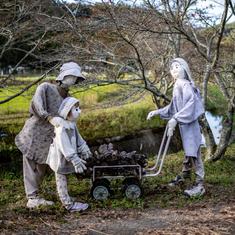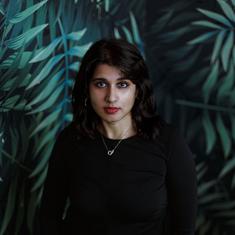Lovelorn maidens, heartless dandies and coquettes, envy, betrayal, languor and heaving passion, all amidst a profusion of moonlight and jasmine. This is the dramatic, and rather medieval, universe of padams and javalis – intensely amorous love verses set in the Carnatic mode and a legacy of the devadasi music and dance traditions of the south.
Mostly in Telugu, and written between the early 19th and early 20th century, the song texts of the javalis and padams are clearly an anachronism in our times – for the nayika is almost always long-suffering and the nayaka is invariably heartless. But these are also themes as old as the hills, of yearning, waiting and wanting, and the music remains eternally beautiful.
Largely shunned for decades on dance and music platforms for their explicit content and social history, some of these songs were brought alive on May 18 by Bharatanatyam dancer Leela Samson accompanied by Carnatic vocalist Savita Narasimhan in Bengaluru. Ee Mohamu (this desire), as the performance organised by Kishima Arts Foundation was aptly titled, showcased six songs of the genre.
“This search and happy discovery of rarer padams and javalis has been on for many years [for me],” said Samson, who embodied the callow young nayikas with moving ease and subtlety.
Though padams and javalis are often spoken of together as one, they do have subtle variations. Padams tend to be slower and more reflective with more devotional underpinnings. Javalis, on the other hand, are more lively and lilting and their lyrics could border on the risque. The dramatis personae in both narratives are one or all of these three – the nayika, nayaka, and sakhi, that critical go-between and sounding board.
Padams and javalis are set to specific ragas embellished with a lot of emotive minutiae to extract a lot of expressive rendition in both singing and dance. The one name that all musicians take with reverence for her artistry in rendering this music is T Brinda, a member of a hereditary artist clan that combined the best of the dance and music worlds. Her grandmother was the great Veena Dhanammal and she was a cousin of the legendary Balasaraswati.
That the padam and javali receded to the margins in Bharatanatyam is a commentary on many things, including our history and politics. But what makes it creatively challenging, said Samson in a post-performance discussion, is the effort it takes to slow down to be in step with the stillness and pauses in the music.
“As a young dancer, a lot of our time goes into the varnam, keertanam, thillana – the nritta [footwork] takes up so much of our heart and soul,” she said. “You are young and full of vigour when that is so challenging, all that kida-thaka-thom, and you want to stretch longer and jump higher. And so you shy away from this, speaking from the heart. Then, suddenly after 10 years of everybody appreciating your nritya, you ask yourself: are we using or misusing them [padams and javalis] only as fillers? What happened to these [songs]?”
The challenge is equally hard for the vocalist. As Savita points out, the genre, especially padams, require tremendous breath control, malleability of voice, and the ability to hold the intensity of music without being aggressive. “This is an inward-looking music and it does not allow you to gallop and it takes years to practise,” she said. “In other forms, the sahityam [text] is set to a fixed meter and but in padams, everything is offbeat and you have to internalise where the phrases fall and how to pace the talam, which are themselves often rare ones.”

The musicality of padams and javalis is singularly exquisite and, when they are danced to, they make for a heady and sensuous shadow play of the visual and the aural.
Shifting mores
Samson remembers, as a child, entering the world of padams at her alma mater, Kalakshetra. “My very first padam was Kshetrayya’s Bala vinave, very slow, beautiful, descriptive, such beauty of musicality and dance,” she told the audience at Sabha, a small performance space in southern Bengaluru. “But to hold Tisra Triputa [taal], the gaps and space at that age was a struggle. But in the early years, you are taught a kai [hand, or set movements] and you did. It is only as you grow older that you start understanding. In fact, you are better able to play a younger nayika as a more mature dancer.” ‘‘i’
She remembers watching the great Mylapore Gowriamma in a class at Kalakshetra. She was frail and aged, one of the legends of the long-gone devadasi era. “She would sit in our class, like a little bundle, and she had a pronounced squint, but if you ask her ‘Gowri patti, show us this’, her whole face would come to life and those eyes would do very beautiful [things] and before you could gather it, it was gone. It was as if some energy came from within her, small nuances.”
With shifting views on gender and sexuality, javalis and padams, especially performed as dance, have had to deal with a lot more contentious issues. Who is all that voluptuousness intended for? Is it spiritual or carnal? Why in an age when women’s agency is being celebrated should they eternally wait for a rogue lover?
At the discussion that followed the dance, some of these questions were raised. But, at this point it might help to step back in time, more precisely two centuries ago, to when the genre grew.
Padams predate javalis, and the names most commonly associated with them are two Telugu bhakti composers, Annamacharya and Kshetrayya. In a sense, they enjoy a firmer reputation for classicism than the sprightly javalis that teeter precariously into the “light” music field.

The origins of the javali and its meaning remain shrouded in mystery, say scholars. In his essay for the music journal Sruti titled Javalis: Jewels of the Dance Repertoire, musicologist Arudra says they were “born in Travancore” in the early 19th-century court of Swati Thirunal, “brought up in Mysore” and “attained their fullness in Madras” before travelling elsewhere in the south. Others believe that its first home was the Mysore court.
The meaning of the name javali itself is contested, says Arudra: interpretations include “lewd song” in Kannada per an 1894 Kannada-English dictionary, “half a song” or javadam in some other works on musicology, and javada in Telugu, meaning a colt of filly to indicate the playful nature of the style. One colonial writer disapprovingly spoke of javalis as “songs of indelicate nature”.
In his essay Salon to Cinema: The Distinctly Modern Life of the Telugu Javali, dance scholar Davesh Soneji points to the different “fields of production” that separate the two forms: padams were the domain of saint composers working in centres of devotion like Tirupati, while “javali composers (javalikartas) worked in the civic heart of the colonial city employed as Taluk clerks or post office workers”.
The javali’s journey through the modern times has been dynamic, the scholar points out, chronicling its transition: it crept into popular Parsi theatre-inspired Tamil dramas of the late 19th and early 20th century; lent itself to linguistic experiment as in the quirky My dear, come, varuvai i vela (come now, my dear) in a mishmash of Tamil, Telugu, Kannada and English; and, once the devadasis were erased from our culturescape, made it to the movies such as in the song Amtalone Telavare from the Telugu film Muddu Bidda (1956).
It was in the salons of the sought-after courtesans of Madras Presidency patronised by elite men that the javali peaked as a creative form in the early 20th century. Among those men was the superb composer and Dhanammal’s patron, Dharmapuri Subbaraya Iyer, a clerk in the taluk office. The stories of their abiding relationship are legend – it is said that the outstanding javali Smara sundarāṅguni was composed by him for her as a gift when she was in dire straits. Performed by Samson at Sabha, it speaks of a rather uniquely progressive beau – considerate and supportive of the nayika’s many talents.
Once the devadasi tradition vanished under the combined onslaught of social outrage and legislation, javalis and padams became more or less outliers in the dance and song repertoire.
In the following, more squeamish decades, the popular narrative was that the heavily sensuous content is to be read not as carnal love but as the soul’s yearning to attain a higher plane. It is quite common for the nayaka in the song to be revealed to be a deity. Samson recalls the somewhat fraught differences between gurus and scholars on the interpretation of loaded words, and the struggle to pin down the direct meanings. Should it be “come, sit by my side” or “come, sit here on my bed”?
But increasingly younger artists are not shying away from their literal meaning.
Among them is vocalist Aishwarya Vidya Raghunath, whose guru was Vegavahini Vijayaraghavan, T Brinda’s daughter and legatee of her powerful felicity with padams and javalis. “We hear padams and javalis so rarely in concerts. But the role of sringara in them, is it something to shy [away] from? It is an important emotion, a transient one and it seeks representation [in the arts] in some way. The argument is that they are tough to render but we persevere with so many tough things in music, why not this?”

There is another question that exercises a lot of young dancers and scholars. In this age of gender equity, what is the relevance of this art form? As dancer Lakshmi Gopalaswamy pointed out at the end of the event, young students want to know: “Why should I dress up and wait for a guy? I dress for myself.”
Samson’s view on this falls uniquely between the conventional and the contemporary.
“These are metaphors, not necessarily about man or woman, though they can be,” she said. “It is about the desire that lies at the root of everything in life, an aspiration, something we constantly want to achieve outside of ourselves. Dancers who say ‘Oh, I am only into the abstract’, then go and show angst, pain. But that too ultimately is this.”
Malini Nair is a culture writer and senior editor based in New Delhi. She can be reached at writermalini@gmail.com.










